It isn't easy to control your tone of voice and how you sound on the internet, whether you're an individual or representing a company.
Even when setting out with the best intentions as a marketer, it’s easy to lapse into clichéd communication styles, making your messaging sound inauthentic.
Memes, slang, and colloquialisms often blend together in the expansive sea of information that is the internet. This can cause you to take on inconsistent or inappropriate verbal attributes without even knowing it.
However, establishing and maintaining an appropriate and consistent tone of voice throughout your content marketing is an essential part of building a strong brand identity online.
Developing brand tone of voice guidelines
Every brand has a unique tone of voice. Embracing yours is an incredibly powerful way to help your target audience recognize you.
How can you do that? Develop tone of voice guidelines.
This is an important first step in defining and documenting your brand voice.
Creating simple voice and tone tables is a great place to start. These short, helpful tips explain how to write for your brand on the web and the rationale behind your guidelines, thus educating the reader about the nuances of content.
This activity isn’t just reserved for big multinational brands; small to mid-sized businesses also have brand voice guidelines. Even small tech companies, government entities, credit unions, colleges, churches, and realtors use these editorial guidelines to guide their content.
Content style guides should be a key element of any organization’s content operations (also known as 'ContentOps'). They align everyone on your content team on the same page so that—whether a copywriter is writing a sales page or a marketer is creating a piece of content for social media—the tone of voice stays consistent.
This is the structure I’ve found to be most effective for writing guidelines:
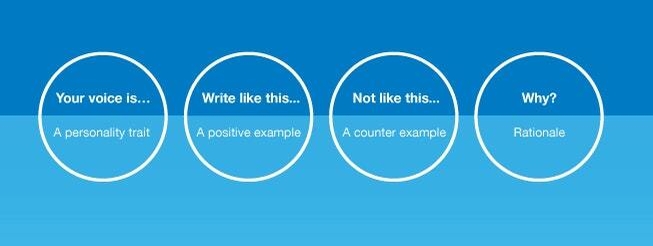 The structure of a tone of voice table
The structure of a tone of voice table
Frequently asked questions about brand voice guidelines
Here are a few things you need to consider before you jump into developing your tone of voice guidelines.
How many voices should be included?
We usually include three to six different traits to be embodied. Depending on the size of the project, some voices may be context-specific.
For example, Help and Support content may be more ‘matter-of-fact,’ whereas research content might be more ‘insightful’ and social media content may be more 'friendly.'
The right level of formality may also vary based on who the content is coming from.
When in a project workflow should they be produced?
We recommend creating voice and tone guidelines after all the main content strategy deliverables have been created (e.g., content inventory, page tables, site map, content governance documentation, etc.). This also allows you to have the best possible grip on your (or your client’s) culture, content, and personality.
What research do you do beforehand?
If existing documentation provides helpful context on brand voice and tone, great! Borrow it. Use what you’ve learned about the brand through your extensive research:
- Discovery sessions
- Stakeholder interviews
- Competitive analysis
- Content audits
- Analytics reviews
On top of this formal research, read through numerous samples of text that have been produced for the company—online and off.
Take note of the ones that perfectly suit or undermine the company's voice until a picture of how they should ideally “sound” starts to emerge.
Fleshing out the tone of voice table
It’s time to start creating the guidelines. From your earlier research, you should already know the core aspects of your voice and brand.
What are some personality attributes that could sum up those aspects? Can you find some examples that illustrate those traits? Can you also find some negative tone of voice examples or make some up?
Ultimately, you should end up with a positive example, a negative example, and a reason for each attribute.
To illustrate, here’s one of three pillars we created for a kids’ teaching resources site:
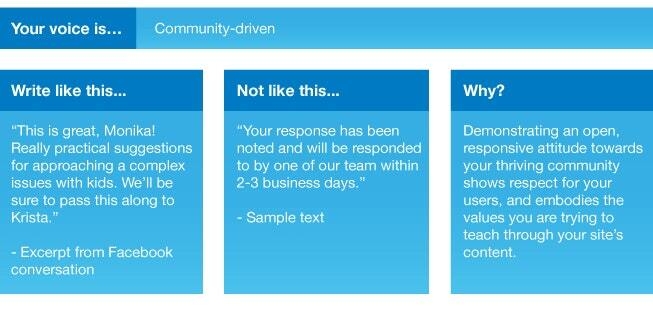 Example of a tone of voice table for a kids’ teaching resources site
Example of a tone of voice table for a kids’ teaching resources site
And here’s one of five guidelines we created for a college in California:
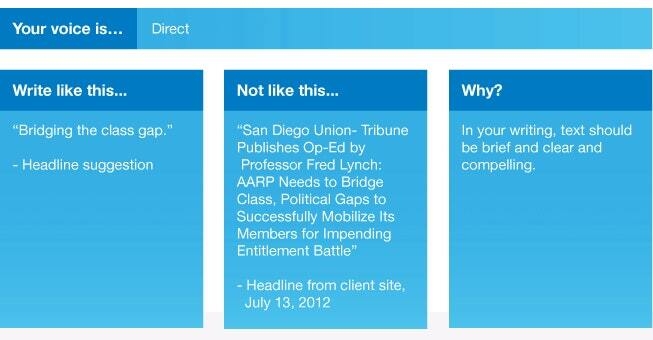 Example of a tone of voice table for a California college
Example of a tone of voice table for a California college
Just as you aim to produce dynamic speakers and writers, so too should your communication be polished and effective.
Here is another excerpt, this one from a government arm in BC. In this example, there were a total of six personality traits:
- Helpful
- Empowering
- Light
- Professional
- Entertaining
- Real
Together, these create the acronym HELPER, with acronyms being a useful memory tool for content writers. In this case, writers could remember that if they were writing like a “helper,” their voice would be on track.
Here’s what the pillar for the word “Empowering” looked like:
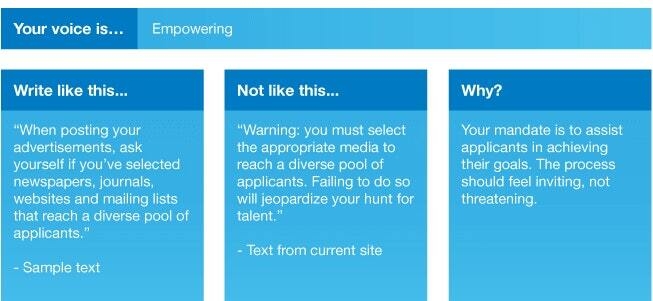 Example of a tone of voice table for a government website
Example of a tone of voice table for a government website
In your case, the result should be a simple one-page guide with five or so concrete examples of how to write and how not to write.
Three reasons why the tone of voice is important
It’s no exaggeration to say that a clear tone of voice is vital to helping you stand out in the crowded marketplace. Here’s why it’s important to take the time to define your tone of voice:
1. Many writers, one brand
The role of web writing is often decentralized, with responsibilities shared between many different content authors in many different places. Guidelines can be helpful as a central reference to keep the overall voice consistent.
2. Consistency is memorable
Creating consistent content results in great experiences for your target audience and builds loyalty. Think of the micro-text you loved on the original Flickr or why you get a kick out of Mailchimp. They didn’t just pick default text; they created the right tone of voice to fit their brand values and culture. And they made this ubiquitous.
3. Death to corporate blah
Many of us write our 'corporate' web content with a kind of mind-numbing pseudo-professionalism. Social updates, newsletters, and website notifications are often written with such glazed-over blasé that you can almost see the sadness growing in readers’ eyes.
With this deathly dull nonsense, we make a universe where meaningless phrases abound, simplicity is avoided, and jargon reigns. It’s time to stop—it’s rude to write like that. Voice and tone guidelines can help establish professionalism without drifting into corporate blah.
But a word of caution: As a reaction to 'corporate blah,' some writers have swung the other way into 'casual blah.' They adopt a tone of chattiness to appear more personable, regardless of whether it suits the brand.
Avoid this...it’s just as bad as its corporate counterpart.
Tone of voice examples that stand out for the right reasons
Seeing brand voice in action makes it easier to understand how your tone of voice can impact your brand’s message. Here are some excellent tone of voice examples:
Mailchimp
We talked about Mailchimp earlier, so it’s only fair to show its tone of voice at work in its content. Mailchimp’s voice and tone are informal and fun. They aren’t unprofessional, but they are down-to-earth and appealing to the company’s customers.
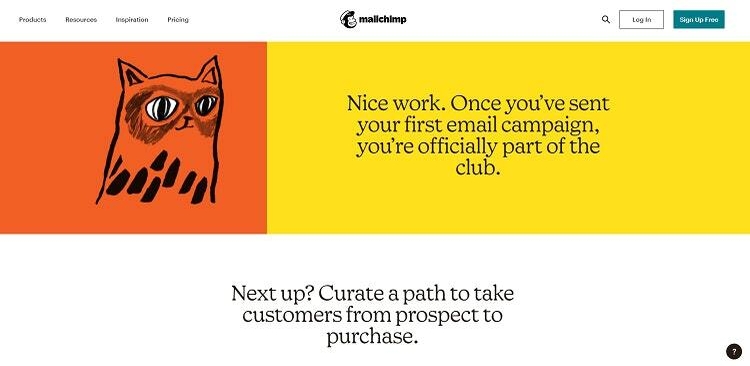 Mailchimp uses its brand voice and unique sense of humor to stand out online. (Image source)
Mailchimp uses its brand voice and unique sense of humor to stand out online. (Image source)
A conversational, easy-to-understand tone is a cornerstone of Mailchimp’s voice and tone. And it also utilizes offbeat humor to stand out in an industry that can often be quite dry.
Coca-Cola
Coca-Cola is an iconic brand that has stood the test of time…and for good reason! Its brand voice is positive, friendly, and happy. When you read a Coke advertisement or watch a commercial, you can’t help but feel that happiness yourself.
 Coca-Cola’s voice and imagery highlight its core values, both of which contribute to its memorability and popularity (Image source)
Coca-Cola’s voice and imagery highlight its core values, both of which contribute to its memorability and popularity (Image source)
To create this tone of voice, Coca-Cola uses positive language and messages throughout its messaging. From its website homepage to its advertisements, its core values are front and center, and the experience it delivers is always consistent.
Nike
Nike is another brand with a distinct, recognizable brand voice. Nike’s voice is positive, friendly, and motivating, which resonates with its target audience—sports and fitness enthusiasts.
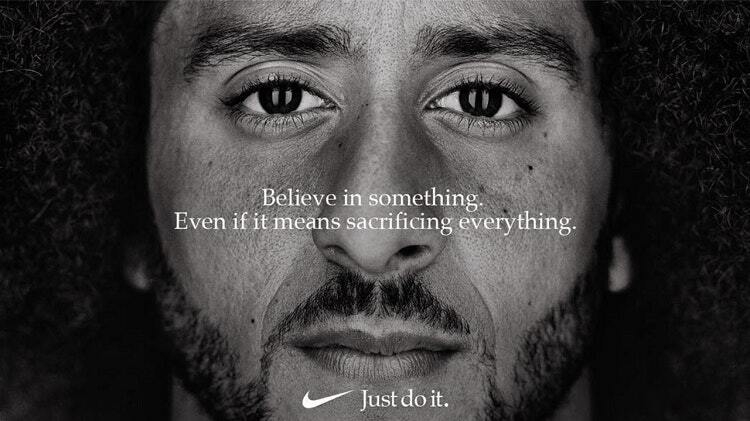 Nike creates impactful messaging by coupling its positive, inspiring brand voice with clarity and brevity (Image source)
Nike creates impactful messaging by coupling its positive, inspiring brand voice with clarity and brevity (Image source)
Take, for example, the company’s world-famous “just do it” tagline. The tone is inspiring and motivating (as expected) without being wordy or elaborate. It’s short, simple, and to the point but still meaningful for Nike’s target market.
Starbucks
Coffee giant Starbucks alternates between two different voices—functional and expressive. The former, which prioritizes using clear language, makes the Starbucks user experience (like ordering) easy to navigate.
On the other hand, the brand uses expressive language to “present a product truth in a fresh, relevant, interesting way.”
 An example of Starbucks’ expressive brand tone (Image source)
An example of Starbucks’ expressive brand tone (Image source)
This flexible approach provides an important reminder. For maximum effectiveness, you can and should use different tones for different types of messaging. However, they must still be clearly defined, used according to set guidelines, and naturally fall under the umbrella of your overall brand voice.
Uber
Lastly, there’s Uber, which has been very intentional about expressing its brand essence. As explained in Uber’s tone of voice guide, it maintains a recognizable voice by being direct, bold, and writing from a place of passion and conviction.
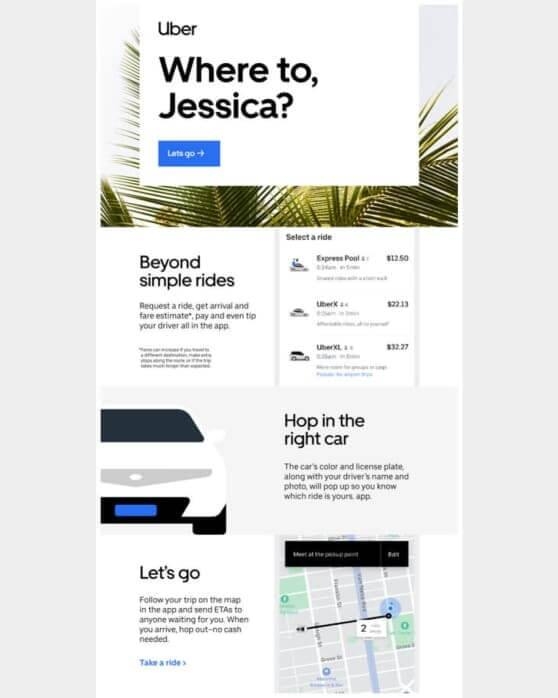 An example of Uber’s distinct, clear, audience-first tone of voice (Image source)
An example of Uber’s distinct, clear, audience-first tone of voice (Image source)
Uber consistently uses straightforward, easy-to-understand, audience-first language, which is a best practice for all companies. Yet, it still finds ways to differentiate its voice from other brands. Strive to do the same—carving out your own way of communicating without sacrificing clarity or impact.
Take control of your organization’s voice and tone
Marketers often stumble into their companies’ voices and tones accidentally. But it doesn’t have to be this way, and it shouldn’t, especially since we’re talking about an asset as powerful as our words.
You have the opportunity to influence the emotions and reactions of your audience and customers for the better.
Why wait to take advantage of that opportunity?










